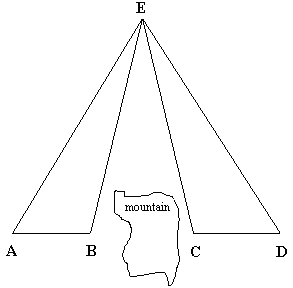
One problem encountered in Surveying
is:
How do you find the length of the baseline AD when it is
interrupted by an obstacle? The obstacle in question is a
mountain that the surveyor cannot see through. The surveyor knows
that each measurement costs money so she decides to minimize the
number of measurements she has to make. The following
observations were made:

Length AB = 436.3m = x
Length BC = ? = y, and
Length CD = 542.8m = z.
Problem: What is length BC?
Solution:
Two pairs of triangles are considered in turn: first ΔEAB and
ΔECA; next ΔEBD and ΔECD.
In ΔEAB

In ΔEAC

EB and EC both contain an angle that has not been measured and
about which there is no information. However, by finding the
ratio EB:EC that can be resolved.

Next consider ΔEBD and ΔECD. The same reasoning for these two
triangles shows that

Thus,

The only unknown in this equation is y, the distance BC
through the mountain. The equation can be rearranged into a
quadratic equation in y.

By plugging in the given values two roots are found for y.
y1 = 150.26 m and y2 = -1129.36 m
The solution is obviously 150.26m but why is y2 equal to the magnitude of AD?



